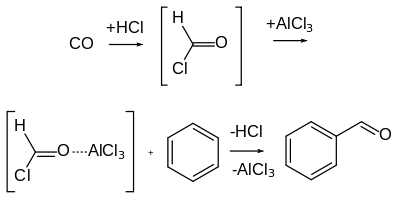Gattermann reaction
The Gattermann reaction, (also known as the Gattermann formylation and the Gattermann salicylaldehyde synthesis) is a chemical reaction in which aromatic compounds are formylated by a mixture of hydrogen cyanide (HCN) and hydrogen chloride (HCl) in the presence of a Lewis acid catalyst such as AlCl3. It is named for the German chemist Ludwig Gattermann[1] and is similar to the Friedel–Crafts reaction.


| Gattermann formylation | |
|---|---|
| Named after | Ludwig Gattermann |
| Reaction type | Substitution reaction |
| Identifiers | |
| RSC ontology ID | RXNO:0000139 |
The reaction can be simplified by replacing the HCN/AlCl3 combination with zinc cyanide.[2] Although it is also highly toxic, Zn(CN)2 is a solid, making it safer to work with than gaseous HCN.[3] The Zn(CN)2 reacts with the HCl to form the key HCN reactant and Zn(CN)2 that serves as the Lewis-acid catalyst in-situ. An example of the Zn(CN)2 method is the synthesis of mesitaldehyde from mesitylene.[4]
Gattermann–Koch reaction
| Gattermann–Koch formylation | |
|---|---|
| Named after | Ludwig Gattermann Julius Arnold Koch |
| Reaction type | Substitution reaction |
The Gattermann–Koch reaction, named after the German chemists Ludwig Gattermann and Julius Arnold Koch,[5] is a variant of the Gattermann reaction in which carbon monoxide (CO) is used instead of hydrogen cyanide.[6]

Unlike the Gattermann reaction, this reaction is not applicable to phenol and phenol ether substrates.[3] Although the highly unstable formyl chloride was initially postulated as an intermediate, formyl cation (i.e., protonated carbon monoxide), [HCO]+, is now thought to be react directly with the arene without the initial formation of formyl chloride.[7] Additionally, when zinc chloride is used as the catalyst, or when the carbon monoxide is not used at high pressure, the presence of traces of copper(I) chloride or nickel(II) chloride co-catalyst is often necessary. The transition metal co-catalyst may server as a "carrier" by first forming reacting with CO to form a carbonyl complex, which is then transformed into the active electrophile.[8]
See also
- Houben–Hoesch reaction
- Stephen aldehyde synthesis
References
- Gattermann, L.; Berchelmann, W. (1898). "Synthese aromatischer Oxyaldehyde". Berichte der deutschen chemischen Gesellschaft. 31 (2): 1765–1769. doi:10.1002/cber.18980310281.
- Adams R.; Levine, I. (1923). "Simplification of the Gattermann Synthesis of Hydroxy Aldehydes". J. Am. Chem. Soc. 45 (10): 2373–77. doi:10.1021/ja01663a020.
- Adams, Roger (1957). Organic Reactions, Volume 9. New York: John Wiley & Sons, Inc. pp. 38 & 53–54. doi:10.1002/0471264180.or009.02. ISBN 9780471007265.
- Fuson, R. C.; Horning, E. C.; Rowland, S. P.; Ward, M. L. (1955). "Mesitaldehyde". Organic Syntheses. doi:10.15227/orgsyn.023.0057.; Collective Volume, 3, p. 549
- Gattermann, L.; Koch, J. A. (1897). "Eine Synthese aromatischer Aldehyde". Chemische Berichte. 30 (2): 1622–1624. doi:10.1002/cber.18970300288.
- Li, Jie Jack (2003). Name Reactions: A Collection of Detailed Reaction Mechanisms (available on Google Books) (2nd ed.). Springer. p. 157. ISBN 3-540-40203-9.
- Kurti, Laszlo. (2005). Strategic Applications of Named Reactions in Organic Synthesis : Background and Detailed Mechanisms. Czako, Barbara. Burlington: Elsevier Science. ISBN 978-0-08-057541-4. OCLC 850164343.
- Dilke, M. H.; Eley, D. D. (1949). "550. The Gattermann–Koch reaction. Part II. Reaction kinetics". J. Chem. Soc. 0 (0): 2613–2620. doi:10.1039/JR9490002613. ISSN 0368-1769.